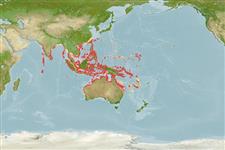Common names from other countries
分類 / Names
共通名の | 類義語 | Catalog of Fishes(部類, 種) | ITIS | CoL | WoRMS | Cloffa
Environment: milieu / climate zone / depth range / distribution range
生態学
海 関連する礁; 深さの範囲 0 - 25 m (Ref. 90102), usually 0 - 20 m (Ref. 27115). Tropical; 25°C - 29°C (Ref. 27115); 27°N - 30°S, 71°E - 171°E
Indo-West Pacific: Maldives, Laccadive Archipelago, India, Sri Lanka, Ogasawara Islands (Japan), eastern Indonesia, New Guinea, Australia, Solomon Islands, Vanuatu, New Caledonia and Philippines; Palau and Yap in Micronesia. Records from Viet Nam (Ref. 2682) is probably Siganus guttatus.
サイズ / 重さ / 年齢
Maturity: Lm ? range ? - ? cm
Max length : 43.0 cm TL オス/雌雄の選別がない; (Ref. 9710); common length : 25.0 cm TL オス/雌雄の選別がない; (Ref. 9813)
背面の脊椎 (合計) : 13; 背鰭 (合計) : 10; 肛門の骨: 7; 臀鰭: 9; 脊つい: 13. This species is distinguished by the following characters: body deep and compressed; greatest body depth 1.9-2.2 in SL; longest dorsal-fin spines 4th to 8th, a little longer (1.1-1.3 times) the last dorsal-fin spine. Colour blue dorsally, silvery below; horizontal golden bronze bands, some broken, running along single sides of trunk, breaking up into spots near bases of dorsal and anal fins and on caudal peduncle, and (except in specimens from South India), spots also on nape; iris silvery and unspotted. Similar with Siganus guttatus in having a diagonal line across cheek from below orbit to corner of mouth, a bright yellow spot about size of orbit on sides at base of last few rays of dorsal fin, and a bluish caudal fin with rows of golden spots which appear as 3 or 4 cross bars on the folded fin. Differs with Siganus guttatus mainly by having mainly lines instead of spots (Ref. 9813, 90102).
Adults inhabit shallow areas, typically 5 m; juveniles common around estuarine areas including mangrove areas and seagrass flats; adults in protected waters such as lagoons and bays in the vicinity of rocky substrata or reefs (resting on rubble or sandy bottoms). Form schools that diminish with age, down to 10-25 fish by adult stage, although congregations may consist of several thousand fish during spawning period. Feed by scraping encrusting algae from beach rock or pavement areas of coral reefs or by browsing on larger coarse algae. Caught mainly with set nets and fixed traps; common in markets where it is sold fresh (Ref. 9813).
Life cycle and mating behavior
Maturities | 繁殖 | Spawnings | Egg(s) | Fecundities | 幼生
Smallest female to spawn was 23 cm, the largest 33 cm SL. Spawning apparently occurs not until the fish is 2 years old.
Woodland, D.J., 1990. Revision of the fish family Siganidae with descriptions of two new species and comments on distribution and biology. Indo-Pac. Fish. (19):136 p. (Ref. 1419)
CITES (Ref. 128078)
Not Evaluated
Human uses
水産業: 商業; 水族館・水槽: 商業
用具
特記事項
XMLをダウンロードして下さい
インターネットの情報源
Estimates based on models
Preferred temperature (Ref.
115969): 24.9 - 29, mean 28 (based on 726 cells).
Phylogenetic diversity index (Ref.
82804): PD
50 = 0.5000 [Uniqueness, from 0.5 = low to 2.0 = high].
Bayesian length-weight: a=0.01738 (0.01067 - 0.02829), b=3.00 (2.86 - 3.14), in cm Total Length, based on LWR estimates for this species & Genus-body shape (Ref.
93245).
栄養段階 (Ref.
69278): 2.0 ±0.00 se; based on food items.
回復力 (Ref.
120179): 高い, 15か月以下の倍増期間の最小個体群 (K=0.6; tm=2).
Fishing Vulnerability (Ref.
59153): Low to moderate vulnerability (25 of 100).
